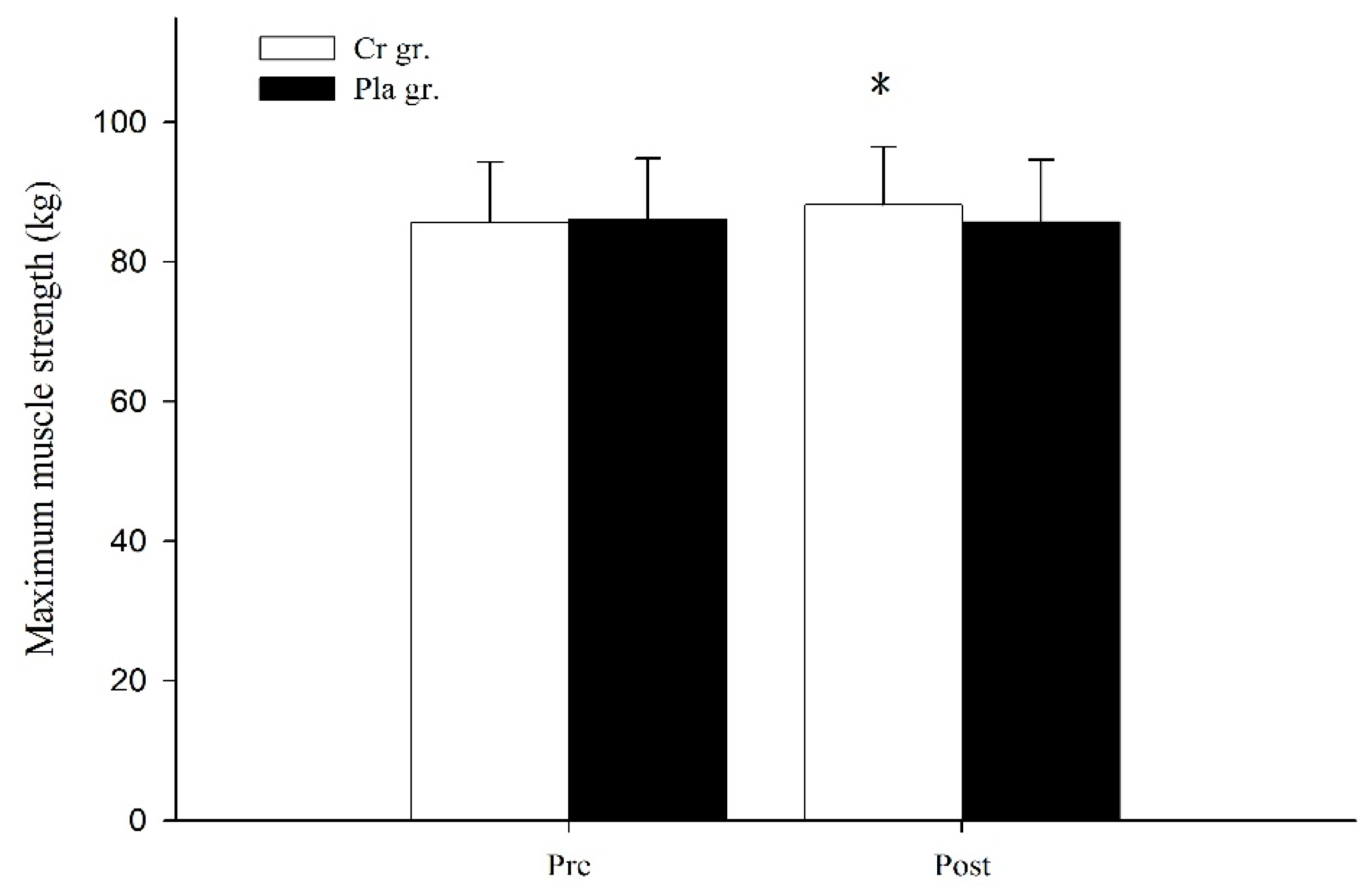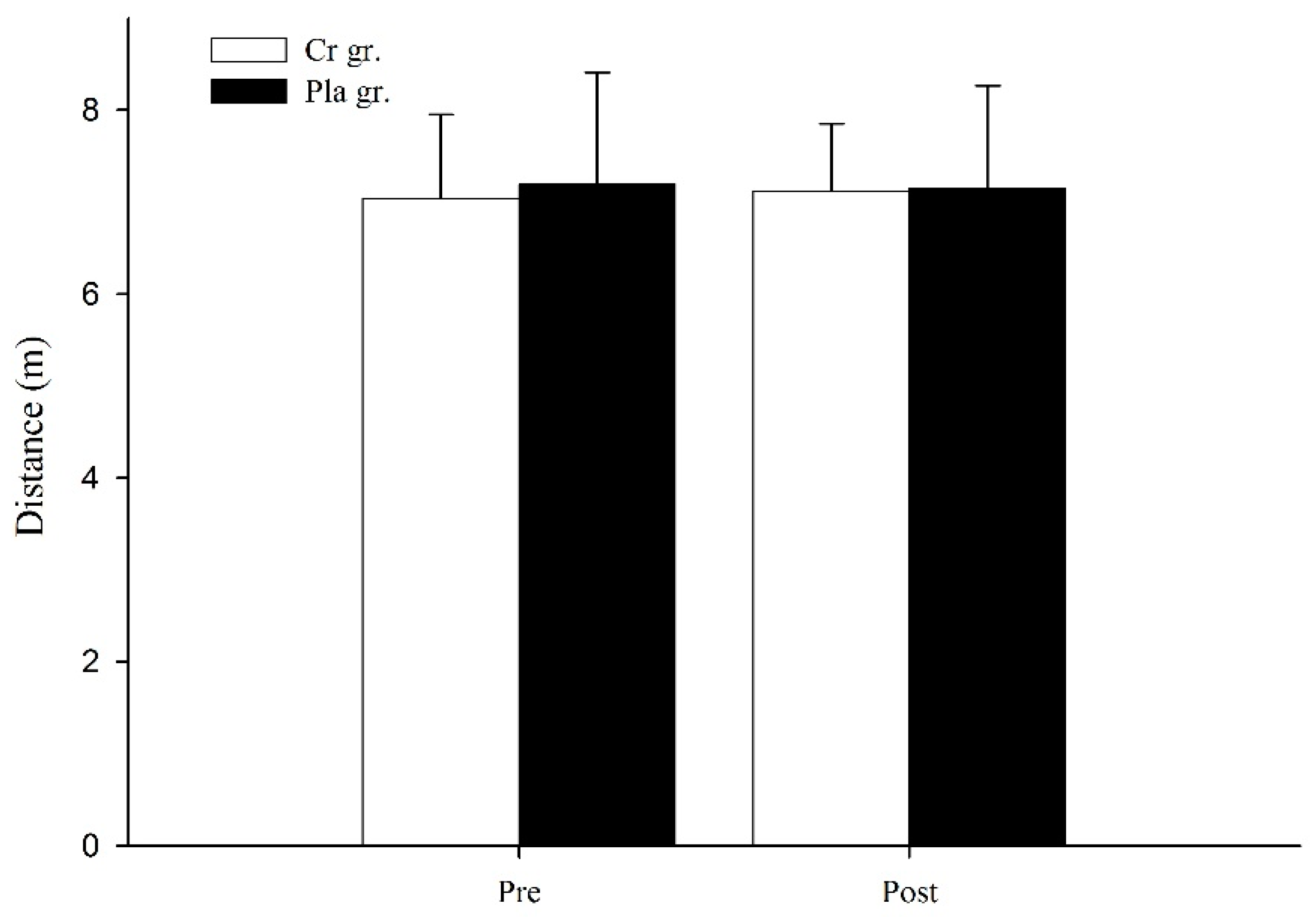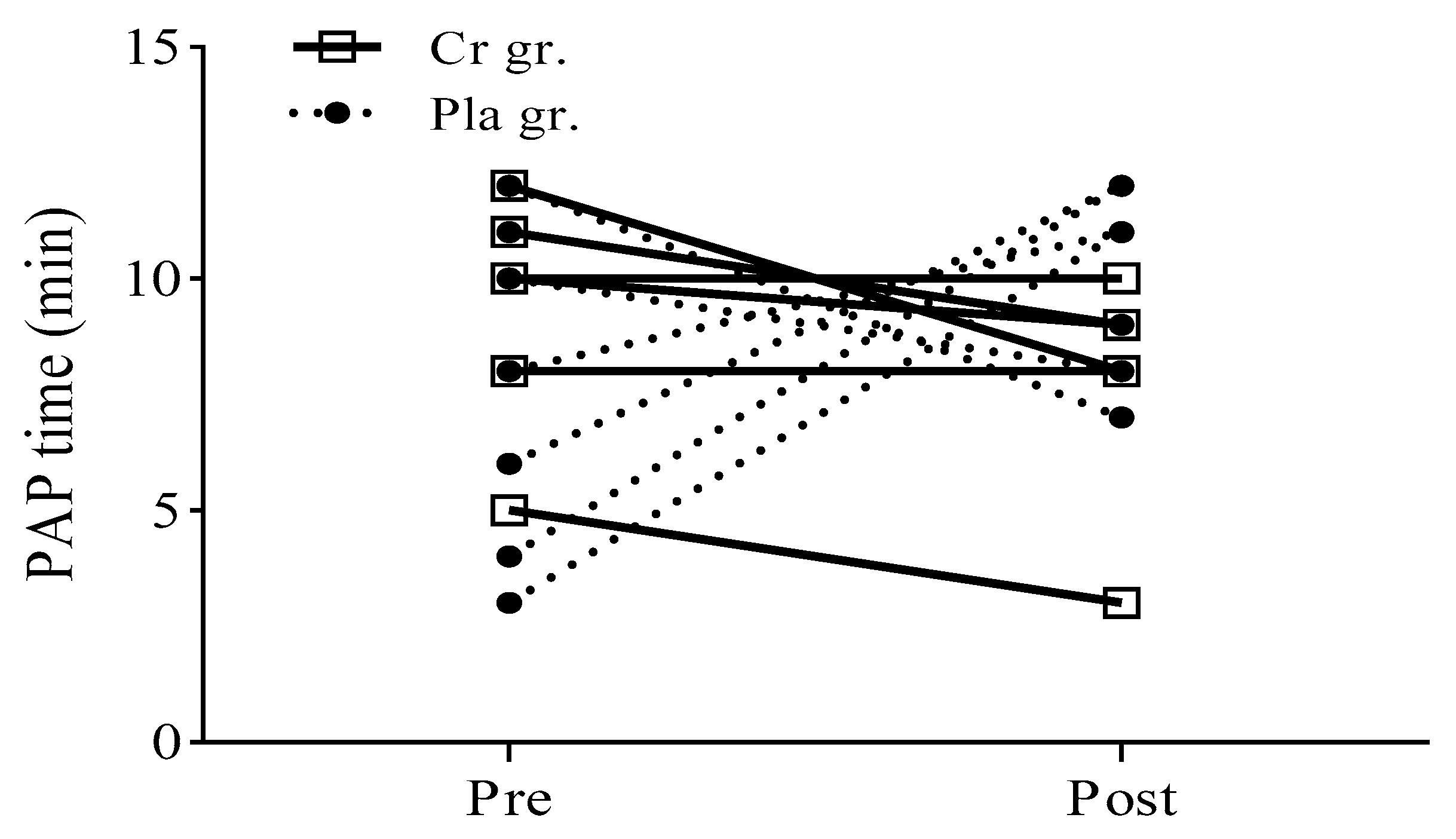Effects of Creatine Supplementation on Muscle Strength and Optimal Individual Post-Activation Potentiation Time of the Upper Body in Canoeists
Abstract
:1. Introduction
2. Experimental Section
2.1. Research Design
2.2. Subjects
2.3. Supplementation Protocol
2.4. Prediction of One Repetition Maximum Strength
2.5. Optimal Individual PAP Time and Overhead Medicine Ball Throw Test
2.6. Anthropometric Measurements
2.7. Statistical Analysis
3. Results
3.1. Subject Characteristics
3.2. Effects of Cr Supplementation on Maximum Upper Body Muscle Strength and Explosive Power in a Set of Complex Training Bouts
3.3. Optimal Individual PAP Time
4. Discussion
5. Conclusions
Acknowledgments
Author Contributions
Conflicts of Interest
References
- Bemben, M.G.; Lamont, H.S. Creatine supplementation and exercise performance: Recent findings. Sports Med. 2005, 35, 107–125. [Google Scholar] [CrossRef] [PubMed]
- Cooper, R.; Naclerio, F.; Allgrove, J.; Jimenez, A. Creatine supplementation with specific view to exercise/sports performance: An update. J. Int. Soc. Sports Nutr. 2012, 9, 33. [Google Scholar] [CrossRef] [PubMed] [Green Version]
- Izquierdo, M.; Ibañez, J.; González-Badillo, J.J.; Gorostiaga, E.M. Effects of creatine supplementation on muscle power, endurance, and sprint performance. Med. Sci. Sports Exerc. 2002, 34, 332–343. [Google Scholar] [CrossRef] [PubMed]
- Bazzucchi, I.; Felici, F.; Sacchetti, M. Effect of short-term creatine supplementation on neuromuscular function. Med. Sci. Sports Exerc. 2009, 41, 1934–1941. [Google Scholar] [CrossRef] [PubMed]
- Docherty, D.; Robbins, D.; Hodgson, M. Complex training revisited: A review of its current status as a viable training approach. Strength Cond. J. 2004, 26, 52–57. [Google Scholar] [CrossRef]
- Tillin, N.A.; Bishop, D. Factors modulating post-activation potentiaiton and its effect on performance of subsequent explosive activities. Sports Med. 2009, 39, 147–166. [Google Scholar] [CrossRef] [PubMed]
- Till, K.A.; Cooke, C. The effects of postactivation potentiation on sprint and jump performance of male academy soccer players. J. Strength Cond. Res. 2009, 23, 1960–1967. [Google Scholar] [CrossRef] [PubMed]
- Rixon, K.P.; Lamont, H.S.; Bemben, M.G. Influence of type of muscle contraction, gender, and lifting experience on postactivation potentiation performance. J. Strength Cond. Res. 2007, 21, 500–505. [Google Scholar] [PubMed]
- Chatzopoulos, D.E.; Michailidis, C.J.; Giannakos, A.K.; Alexiou, K.C.; Patikas, D.A.; Antonopoulos, C.B.; Kotzamanidis, C.M. Postactivation potentiation effects after heavy resistance exercise on running speed. J. Strength Cond. Res. 2007, 21, 1278–1281. [Google Scholar] [PubMed]
- McCann, M.R.; Flanagan, S.P. The effects of exercise selection and rest interval on postactivation potentiation of vertical jump performance. J. Strength Cond. Res. 2010, 24, 1285–1291. [Google Scholar] [CrossRef] [PubMed]
- Esformes, J.I.; Bampouras, T.M. Effect of back squat depth on lower-body postactivation potentiation. J. Strength Cond. Res. 2013, 27, 2997–3000. [Google Scholar] [CrossRef] [PubMed]
- Duthie, G.M.; Young, W.B.; Aitken, D.A. The acute effects of heavy loads on jump squat performance: An evaluation of the complex and contrast methods of power development. J. Strength Cond. Res. 2002, 16, 530–538. [Google Scholar] [CrossRef] [PubMed]
- Hrysomallis, C.; Kidgell, D. Effect of heavy dynamic resistive exercise on acute upper-body power. J. Strength Cond. Res. 2001, 15, 426–430. [Google Scholar] [PubMed]
- Wilson, J.M.; Duncan, N.M.; Marin, P.J.; Brown, L.E.; Loenneke, J.P.; Wilson, S.M.; Jo, E.; Lowery, R.P.; Ugrinowitsch, C. Meta-analysis of postactivation potentiation and power: Effects of conditioning activity, volume, gender, rest periods, and training status. J. Strength Cond. Res. 2013, 27, 854–859. [Google Scholar] [CrossRef] [PubMed]
- Comyns, T.M.; Harrison, A.J.; Hennessy, L.K.; Jensen, R.L. The optimal complex training rest interval for athletes from anaerobic sports. J. Strength Cond. Res. 2006, 20, 471–476. [Google Scholar] [PubMed]
- Evetovich, T.K.; Conley, D.S.; McCawley, P.F. Postactivation potentiation enhances upper- and lower-body athletic performance in collegiate male and female athletes. J. Strength Cond. Res. 2015, 29, 336–342. [Google Scholar] [CrossRef] [PubMed]
- McMahon, S.; Jenkins, D. Factors affecting the rate of phosphocreatine resynthesis following intense exercise. Sports Med. 2002, 32, 761–784. [Google Scholar] [CrossRef] [PubMed]
- Allen, D.G.; Lamb, G.D.; Westerblad, H. Skeletal muscle fatigue: Cellular mechanisms. Physiol. Rev. 2008, 88, 287–332. [Google Scholar] [CrossRef] [PubMed]
- Branch, J.D. Effect of creatine supplementation on body composition and performance: A meta-analysis. Int. J. Sport Nutr. Exerc. Metab. 2003, 13, 198–226. [Google Scholar] [CrossRef] [PubMed]
- Casey, A.; Constantin-Teodosiu, D.; Howell, S.; Hultman, E.; Greenhaff, P.L. Creatine ingestion favorably affects performance and muscle metabolism during maximal exercise in humans. Am. J. Physiol. 1996, 271, E31–E37. [Google Scholar] [PubMed]
- Rahimi, R.; Faraji, H.; Sheikholeslami-Vatani, D.; Vatani, S.D.; Qaderi, M. Creatine supplementation alters the hormonal response to resistance exercise. Kinesiology 2010, 42, 28–35. [Google Scholar]
- Smith, A.E.; Walter, A.A.; Herda, T.J.; Ryan, E.D.; Moon, J.R.; Cramer, J.T.; Stout, J.R. Effects of creatine loading on electromyographic fatigue threshold during cycle ergometry in college-aged women. J. Int. Soc. Sports Nutr. 2007, 4, 20. [Google Scholar] [CrossRef] [PubMed]
- Urbanski, R.L.; Loy, S.F.; Vincent, W.J.; Yaspelkis, B.B., III. Creatine supplementation differentially affects maximal isometric strength and time to fatigue in large and small muscle groups. Int. J. Sport Nutr. 1999, 9, 136–145. [Google Scholar] [CrossRef] [PubMed]
- Zuniga, J.M.; Housh, T.J.; Camic, C.L.; Hendrix, C.R.; Mielke, M.; Johnson, G.O.; Housh, D.J.; Schmidt, R.J. The effects of creatine monohydrate loading on anaerobic performance and one-repetition maximum strength. J. Strength Cond. Res. 2012, 26, 1651–1656. [Google Scholar] [CrossRef] [PubMed]
- Wang, C.C.; Yang, M.T.; Lu, K.H.; Chan, K.H. The effects of creatine supplementation on explosive performance and optimal individual postactivation potentiation time. Nutrients 2016, 8, 143. [Google Scholar] [CrossRef] [PubMed]
- Lanhers, C.; Pereira, B.; Naughton, G.; Trousselard, M.; Lesage, F.X.; Dutheil, F. Creatine supplementation and lower limb strength performance: A systematic review and meta-analyses. Sports Med. 2015, 45, 1285–1294. [Google Scholar] [CrossRef] [PubMed]
- Lanhers, C.; Pereira, B.; Naughton, G.; Trousselard, M.; Lesage, F.X.; Dutheil, F. Creatine supplementation and upper limb strength performance: A systematic review and meta-analysis. Sports Med. 2017, 47, 163–173. [Google Scholar] [CrossRef] [PubMed]
- Robbins, D.W. Postactivation potentiation and its practical applicability: A brief review. J. Strength Cond. Res. 2005, 19, 453–458. [Google Scholar] [CrossRef] [PubMed]
- Kilduff, L.P.; Owen, N.; Bevan, H.; Bennett, M.; Kingsley, M.I.; Cunningham, D. Influence of recovery time on post-activation potentiation in professional rugby players. J. Sports Sci. 2008, 26, 795–802. [Google Scholar] [CrossRef] [PubMed]
- Crewther, B.T.; Kilduff, L.P.; Cook, C.J.; Middleton, M.K.; Bunce, J.P.; Yang, G.Z. The acute potentiating effects of back squats on athlete performance. J. Strength Cond. Res. 2011, 25, 3319–3325. [Google Scholar] [CrossRef] [PubMed]
- Kilduff, L.P.; Bevan, H.R.; Kingsley, M.I.C.; Owen, N.J.; Bennett, M.A.; Bunce, P.J.; Hore, A.M.; Maw, J.R.; Cunningham, D.J. Postactivation potentiation in professional rugby players: Optimal recovery. J. Strength Cond. Res. 2007, 21, 1134–1138. [Google Scholar] [CrossRef] [PubMed]
- Baechle, T.R.; Earle, R.W. Essentials of Strength Training and Conditioning, 2nd ed.; Human Kinetics Publishers: Champaign, IL, USA, 2008; pp. 406–413. [Google Scholar]
- Gabbett, T.; Georgieff, B. Physiological and anthropometric characteristics of Australian junior national, state, and novice volleyball players. J. Strength Cond. Res. 2007, 21, 902–908. [Google Scholar] [PubMed]
- Viitasalo, J.T. Evaluation of explosive strength for young and adult athlete. Res. Q. Exerc. Sport 1988, 59, 9–13. [Google Scholar] [CrossRef]
- Vossen, J.F.; Kramer, J.F.; Burke, D.G.; Vossen, D.P. Comparison of dynamic push-up training and plyometric push-up training on upper-body power and strength. J. Strength Cond. Res. 2000, 14, 248–253. [Google Scholar]
- Ebben, W.P. Complex training: A brief review. J. Sports Sci. Med. 2002, 1, 42–46. [Google Scholar] [PubMed]
- Murphy, R.M.; Stephenson, D.G.; Lamb, G.D. Effect of creatine on contractile force and sensitivity in mechanically skinned single fibers from rat skeletal muscle. Am. J. Physiol. Cell Physiol. 2004, 287, C1589–C1595. [Google Scholar] [CrossRef] [PubMed]
- Naclerio, F.; Chapman, M.; Larumbe-Zabala, E.; Massey, B.; Neil, A.; Triplett, T.N. Effects of three different conditioning activity volumes on the optimal recovery time for potentiation in college athletes. J. Strength Cond. Res. 2015, 29, 2579–2585. [Google Scholar] [CrossRef] [PubMed]
- Hamada, T.; Sale, D.G.; MacDougall, J.D.; Tarnopolsky, M.A. Postactivation potentiation, fiber type, and twitch contraction time in human knee extensor muscles. J. Appl. Physiol. 2000, 88, 2131–2137. [Google Scholar] [PubMed]
- Requena, B.; Gapeyeva, H.; García, I.; Ereline, J.; Pääsuke, M. Twitch potentiation after voluntary versus electrically induced isometric contractions in human knee extensor muscles. Eur. J. Appl. Physiol. 2008, 104, 463–472. [Google Scholar] [CrossRef] [PubMed]
- Pääsuke, M.; Saapar, L.; Ereline, J.; Gapeyeva, H.; Requena, B.; Oopik, V. Postactivation potentiation of knee extensor muscles in power- and endurance-trained, and untrained women. Eur. J. Appl. Physiol. 2007, 101, 577–585. [Google Scholar] [CrossRef] [PubMed]
- Jubeau, M.; Gondin, J.; Martin, A.; Van Hoecke, J.; Maffiuletti, N.A. Differences in twitch potentiation between voluntary and stimulated quadriceps contractions of equal intensity. Scand. J. Med. Sci. Sports 2010, 20, e56–e62. [Google Scholar] [CrossRef] [PubMed]
- Hamada, T.; Sale, D.G.; Macdougall, J.D. Postactivation potentiation in endurance-trained male athletes. Med. Sci. Sports Exerc. 2000, 32, 403–411. [Google Scholar] [CrossRef] [PubMed]
- Seitz, L.B.; Trajano, G.S.; Dal Maso, F.; Haff, G.G.; Blazevich, A.J. Postactivation potentiation during voluntary contractions after continued knee extensor task-specific practice. Appl. Physiol. Nutr. Metab. 2015, 40, 230–237. [Google Scholar] [CrossRef] [PubMed]



| Variable | Cr group (n = 8) | Pla group (n = 9) |
|---|---|---|
| Age (years) | 16.75 ± 0.70 | 16.44 ± 1.13 |
| Height (cm) | 169.48 ± 3.61 | 172.16 ± 3.53 |
| Weight (kg) | 65.33 ± 4.65 | 64.34 ± 7.14 |
| Body fat (%) | 14.50 ± 2.58 | 13.20 ± 2.96 |
© 2017 by the authors. Licensee MDPI, Basel, Switzerland. This article is an open access article distributed under the terms and conditions of the Creative Commons Attribution (CC BY) license (http://creativecommons.org/licenses/by/4.0/).
Share and Cite
Wang, C.-C.; Lin, S.-C.; Hsu, S.-C.; Yang, M.-T.; Chan, K.-H. Effects of Creatine Supplementation on Muscle Strength and Optimal Individual Post-Activation Potentiation Time of the Upper Body in Canoeists. Nutrients 2017, 9, 1169. https://doi.org/10.3390/nu9111169
Wang C-C, Lin S-C, Hsu S-C, Yang M-T, Chan K-H. Effects of Creatine Supplementation on Muscle Strength and Optimal Individual Post-Activation Potentiation Time of the Upper Body in Canoeists. Nutrients. 2017; 9(11):1169. https://doi.org/10.3390/nu9111169
Chicago/Turabian StyleWang, Chia-Chi, Shu-Cheng Lin, Shu-Ching Hsu, Ming-Ta Yang, and Kuei-Hui Chan. 2017. "Effects of Creatine Supplementation on Muscle Strength and Optimal Individual Post-Activation Potentiation Time of the Upper Body in Canoeists" Nutrients 9, no. 11: 1169. https://doi.org/10.3390/nu9111169




